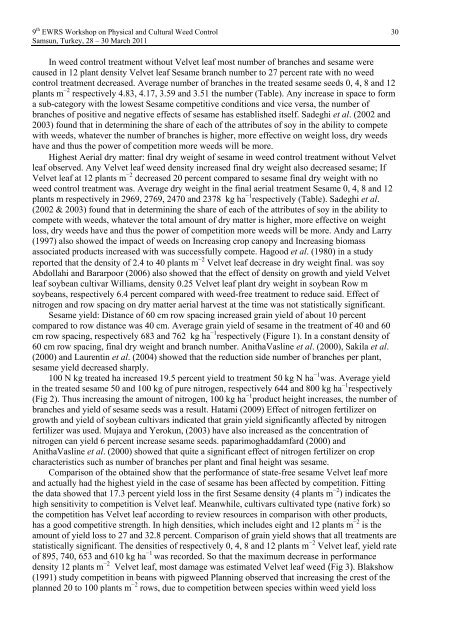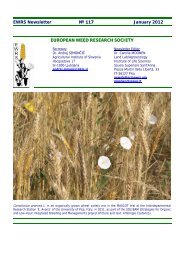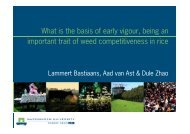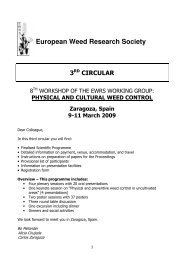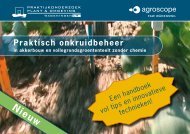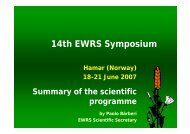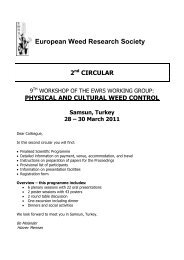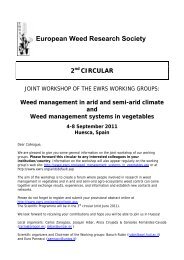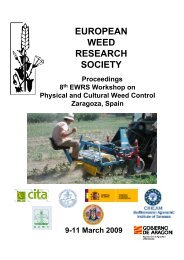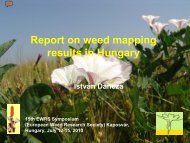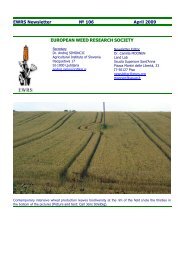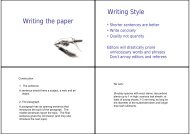Physical and Cultural Weed Control Working Group of - European ...
Physical and Cultural Weed Control Working Group of - European ...
Physical and Cultural Weed Control Working Group of - European ...
Create successful ePaper yourself
Turn your PDF publications into a flip-book with our unique Google optimized e-Paper software.
9 th EWRS Workshop on <strong>Physical</strong> <strong>and</strong> <strong>Cultural</strong> <strong>Weed</strong> <strong>Control</strong> 30<br />
Samsun, Turkey, 28 – 30 March 2011<br />
In weed control treatment without Velvet leaf most number <strong>of</strong> branches <strong>and</strong> sesame were<br />
caused in 12 plant density Velvet leaf Sesame branch number to 27 percent rate with no weed<br />
control treatment decreased. Average number <strong>of</strong> branches in the treated sesame seeds 0, 4, 8 <strong>and</strong> 12<br />
plants m −2 respectively 4.83, 4.17, 3.59 <strong>and</strong> 3.51 the number (Table). Any increase in space to form<br />
a sub-category with the lowest Sesame competitive conditions <strong>and</strong> vice versa, the number <strong>of</strong><br />
branches <strong>of</strong> positive <strong>and</strong> negative effects <strong>of</strong> sesame has established itself. Sadeghi et al. (2002 <strong>and</strong><br />
2003) found that in determining the share <strong>of</strong> each <strong>of</strong> the attributes <strong>of</strong> soy in the ability to compete<br />
with weeds, whatever the number <strong>of</strong> branches is higher, more effective on weight loss, dry weeds<br />
have <strong>and</strong> thus the power <strong>of</strong> competition more weeds will be more.<br />
HighestAerial dry matter: final dry weight <strong>of</strong> sesame in weed control treatment without Velvet<br />
leaf observed. Any Velvet leaf weed density increased final dry weight also decreased sesame; If<br />
Velvet leaf at 12 plants m −2 decreased 20 percent compared to sesame final dry weight with no<br />
weed control treatment was. Average dry weight in the final aerial treatment Sesame 0, 4, 8 <strong>and</strong> 12<br />
plants m respectively in 2969, 2769, 2470 <strong>and</strong> 2378 kg ha −1 respectively (Table). Sadeghi et al.<br />
(2002 & 2003) found that in determining the share <strong>of</strong> each <strong>of</strong> the attributes <strong>of</strong> soy in the ability to<br />
compete with weeds, whatever the total amount <strong>of</strong> dry matter is higher, more effective on weight<br />
loss, dry weeds have <strong>and</strong> thus the power <strong>of</strong> competition more weeds will be more. Andy <strong>and</strong> Larry<br />
(1997) also showed the impact <strong>of</strong> weeds on Increasing crop canopy <strong>and</strong> Increasing biomass<br />
associated products increased with was successfully compete. Hagood et al. (1980) in a study<br />
reported that the density <strong>of</strong> 2.4 to 40 plants m −2 Velvet leaf decrease in dry weight final.was soy<br />
Abdollahi <strong>and</strong> Bararpoor (2006) also showed that the effect <strong>of</strong> density on growth <strong>and</strong> yield Velvet<br />
leaf soybean cultivar Williams, density 0.25 Velvet leaf plant dry weight in soybean Row m<br />
soybeans, respectively 6.4 percent compared with weed-free treatment to reduce said. Effect <strong>of</strong><br />
nitrogen <strong>and</strong> row spacing on dry matter aerial harvest at the time was not statistically significant.<br />
Sesame yield: Distance <strong>of</strong> 60 cm row spacing increased grain yield <strong>of</strong> about 10 percent<br />
compared to row distance was 40 cm. Average grain yield <strong>of</strong> sesame in the treatment <strong>of</strong> 40 <strong>and</strong> 60<br />
cm row spacing, respectively 683 <strong>and</strong> 762 kg ha −1 respectively (Figure 1). In a constant density <strong>of</strong><br />
60 cm row spacing, final dry weight <strong>and</strong> branch number. AnithaVasline et al. (2000), Sakila et al.<br />
(2000) <strong>and</strong> Laurentin et al. (2004) showed that the reduction side number <strong>of</strong> branches per plant,<br />
sesame yield decreased sharply.<br />
100 N kg treated ha increased 19.5 percent yield to treatment 50 kg N ha −1 was. Average yield<br />
in the treated sesame 50 <strong>and</strong> 100 kg <strong>of</strong> pure nitrogen, respectively 644 <strong>and</strong> 800 kg ha −1 respectively<br />
(Fig 2). Thus increasing the amount <strong>of</strong> nitrogen, 100 kg ha −1 product height increases, the number <strong>of</strong><br />
branches <strong>and</strong> yield <strong>of</strong> sesame seeds was a result. Hatami (2009) Effect <strong>of</strong> nitrogen fertilizer on<br />
growth <strong>and</strong> yield <strong>of</strong> soybean cultivars indicated that grain yield significantly affected by nitrogen<br />
fertilizer was used. Mujaya <strong>and</strong> Yerokun, (2003) have also increased as the concentration <strong>of</strong><br />
nitrogen can yield 6 percent increase sesame seeds. paparimoghaddamfard (2000) <strong>and</strong><br />
AnithaVasline et al. (2000) showed that quite a significant effect <strong>of</strong> nitrogen fertilizer on crop<br />
characteristics such as number <strong>of</strong> branches per plant <strong>and</strong> final height was sesame.<br />
Comparison <strong>of</strong> the obtained show that the performance <strong>of</strong> state-free sesame Velvet leaf more<br />
<strong>and</strong> actually had the highest yield in the case <strong>of</strong> sesame has been affected by competition. Fitting<br />
the data showed that 17.3 percent yield loss in the first Sesame density (4 plants m −2 ) indicates the<br />
high sensitivity to competition is Velvet leaf. Meanwhile, cultivars cultivated type (native fork) so<br />
the competition has Velvet leaf according to review resources in comparison with other products,<br />
has a good competitive strength. In high densities, which includes eight <strong>and</strong> 12 plants m −2 is the<br />
amount <strong>of</strong> yield loss to 27 <strong>and</strong> 32.8 percent. Comparison <strong>of</strong> grain yield shows that all treatments are<br />
statistically significant. The densities <strong>of</strong> respectively 0, 4, 8 <strong>and</strong> 12 plants m −2 Velvet leaf, yield rate<br />
<strong>of</strong> 895, 740, 653 <strong>and</strong> 610 kg ha −1 was recorded. So that the maximum decrease in performance<br />
density 12 plants m −2 Velvet leaf, most damage was estimated Velvet leaf weed (Fig 3). Blakshow<br />
(1991) study competition in beans with pigweed Planning observed that increasing the crest <strong>of</strong> the<br />
planned 20 to 100 plants m −2 rows, due to competition between species within weed yield loss


